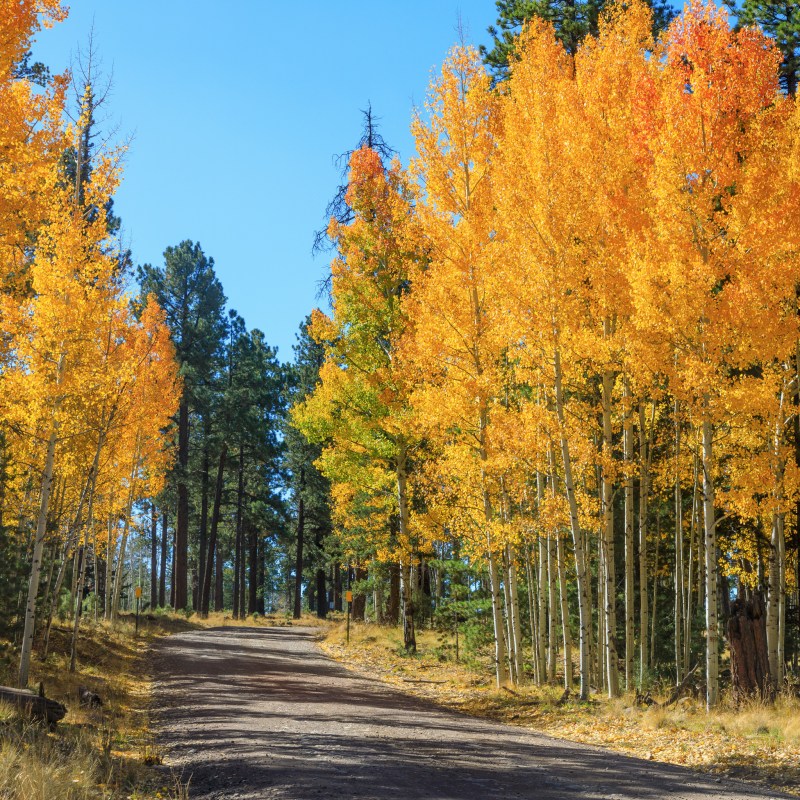
Truthfully, every season is gorgeous in the White Mountains of eastern Arizona. In the spring and summer, the banks of babbling creeks erupt with wildflowers, and in the winter, the rugged peaks and sloping meadows are blanketed in sparkling white.
Videos by TravelAwaits
But it is perhaps in autumn that the White Mountains are at their brightest. Interspersed with the mountains’ pine and fir trees are lovely stands of white-barked aspens and thickets of Gambel oaks.
In late September and early October, the changing colors of the aspens and oaks alternate with the evergreen pines, creating a striking green-and-gold patchwork landscape.
Fall is also a time of glorious weather in Arizona’s high country. Owing to its altitudes that soar to the 6,500-to-9,000-foot-plus range, the White Mountains are always considerably cooler than the lowland deserts of the Phoenix and Tucson areas.
Average high temperatures in White Mountain communities such as Greer and Show Low are in the 70s and 80s in the summer and in the 60s and 70s in the fall. Prime leaf-peeping typically occurs during the first three weeks of October. The September shoulder season, although it might be too early to see the full range of fall colors, is still a wonderful time to visit the White Mountains.
Here are 11 fantastic things to do in Arizona’s White Mountains in the fall.

1. Make The White Mountains Scenic Drive
Encompassing a broad region that takes in the Mogollon Rim communities of Pine and Strawberry in the west and continuing 150 miles east to the towns of Springerville and Eager near the Arizona-New Mexico border, the White Mountains area includes countless scenic stretches of road.
Among the most eye-catching is the 40-mile drive on Highway 260 between the Hon-Dah Resort Casino in Pinetop and Springerville/Eagar. For even more spectacular terrain, add in a 20-mile detour southeast on the White Mountains Scenic Drive on Highway 273 toward Big Lake and the area’s ski resort, Sunrise Park Resort. Along the way, you’ll pass by immense meadows speckled with ponderosa pines and Douglas firs and bisected by lovely creeks.
In the fall, expect the meadows to be transitioning from vivid green to mellow yellows and browns and the distant peaks to be changing to gold. Plan to take 3 to 4 hours driving the route and stopping at the various overlooks and trailheads along the way.

2. Explore The Rim Country Museum And Zane Grey Cabin
For a crash course in the history of the area known as Rim Country, head to the town of Payson, located on the western edge of the mountain range, and check out the informative Rim Country Museum. Payson and the nearby communities of Pine and Strawberry lie on the Mogollon Rim, a high-cliff region leading up to the White Mountains to the east.
The Rim Country Museum and Zane Grey Cabin are located on the grounds of Payson’s Green Valley Park, which is green and lush in the summer and gold in the fall. The easy walk around the park, with its three picturesque ponds and flowing weeping willows, makes for a wonderful fall outing.

3. Hike A Section Of The Arizona Trail
The Arizona Trail stretches for 800 miles across the state from Utah to Mexico, linking the diverse terrain of deserts, canyons, and mountains.
While adventurous hikers regularly complete the entire daunting trail over weeks, months, or years, day hikers can get a taste of the trail from the Pine Loop Trailhead located in the small community of Pine. The loop, which includes a portion of the Arizona Trail, is a 2.8-mile round trip and is rated as easy.

4. Try A Local Beer In Pine
Located less than 2 hours from Phoenix but a cool 4,000 feet higher, the little town of Pine and its sister town of Strawberry are popular day-trip destinations for residents of the Valley of the Sun metropolitan area.
Many quaint breweries and eateries cater to the summer and fall crowds. Among the best known is THAT Brewery, located along Pine’s main artery of Highway 87. On a warm fall day, try to get a seat on the brewery’s patio, surrounded by towering pine trees. On the brewery menu are local beers such as the Arizona Trail Ale and Fossil Creek IPA. And on the pub menu are specialties such as an Arizona dip sandwich featuring prime rib on Texas toast and a smoked pulled chicken sandwich.
Other places worth checking out are the Pine Provisions, and The Honey Stand.

5. Climb Mount Baldy
At about 11,400 feet elevation, Mount Baldy is the highest point in the White Mountains and among the highest peaks in Arizona (slightly lower than several high points in Flagstaff’s San Francisco Peaks).
Mount Baldy, which is located partially on the Fort Apache Reservation, features a number of beautiful hiking trails through thick pine and aspen forests. Two trailheads for the East Baldy Trail #95 are located along the Highway 273 scenic route.
The two trails merge within a quarter mile and follow the East Fork of the Little Colorado River, offering sweeping views along the way. The trail is 7 miles long (14 miles round trip) and gains about 2,000 feet in elevation. It traverses rugged terrain and is rated as moderate to difficult.

6. Go Boating On Big Lake
Sitting at about 9,000 feet elevation, Big Lake in the Apache-Sitgreaves National Forests is considered one of the best fishing lakes in the White Mountains, yielding plentiful rainbow, brown, and brook trout. And at 575 acres, the lake has a number of access points; signs for lake roads are posted throughout the region.
Aside from being a great place for fishing and boating, Big Lake is known for its many campgrounds. The Apache-Sitgreaves National Forests website notes that nine campgrounds are available, offering proximity to hiking and mountain biking trails, wildlife viewing, and trout fishing. One of the easiest access points is along Highway 273 and Forest Road 8115, where Big Lake Tackle and Supply offers boat rentals and fishing gear.
7. Soak Up The Views At Crescent Lake
For a smaller and more low-key lake experience, consider Crescent Lake, a pretty spot about 2 miles north of Big Lake. Located just off Highway 273, the lake is easy to access and has restrooms and picnic areas.

8. Hike Creekside On The Thompson Trail
The Thompson Trail in the Apache-Sitgreaves National Forests is one of the most celebrated trails in the area, and the meandering route more than lives up to the hype.
The trail follows the West Fork of the Black River, passing through meadows dotted with a rainbow of wildflowers in the spring and summer and past stands of pines and aspens that offer a mix of colors in the fall. Getting to the trailhead requires a 4-mile drive on a somewhat rough, but passable, dirt road. The hike is 6.5 miles round trip with little elevation gain. It passes through rough and sometimes soggy terrain and is rated easy to moderate.
9. Sample The Mountain Life In Greer
The little village of Greer might just be the epitome of rustic mountain town Arizona. With a population of less than 100 full-time residents, the town in the heart of the White Mountains offers a surprisingly varied choice of rental cabins and recreation options.
Greer is known as a four-season destination, and the autumn brings brisk but sunny days and recreational choices such as hiking, fishing, hunting, camping, and horseback riding. Surrounded by seemingly endless pine and aspen forests, Greer is billed as a spot to experience the spectacular colors of spring, summer, and fall.
10. Camp And Fish At Lyman Lake State Park
For a lake experience that’s a bit warmer than Big Lake and Crescent Lake, Lyman Lake sits at just under 6,000 feet elevation and has summer high temperatures in the 90s and fall highs in the 70s and 80s. The park website notes that the warm, sunny days make Lyman “perfect for fishing, swimming, leisure boating, waterskiing, hiking, or just relaxing.”
Along with its varied activities, the Springerville-area state park also offers camping and rental cabins.
11. Dine In Show Low
At a population of nearly 12,000, Show Low is the area’s largest city and the spot with the most choices for dining and accommodations.
The town also has a fascinating story, reportedly being named for an old high-stakes poker game. “After a long night with no clear winner, one [player] decided to let the cards decide his fate with the phrase, ‘If you show low, you win,’” says the Arizona Tourism website. The name stuck, and the main street through town is dubbed Deuce of Clubs in honor of the low card.
Known as the gateway to the White Mountains, Show Low and neighboring Pinetop offer a range of chain restaurants as well as fun local eateries. For a hearty breakfast or brunch, check out the buttermilk biscuits and gravy at Darbi’s Cafe. For lunch or dinner, try the mesquite-grilled steak and homemade potato chips at the Western-style Charlie Clark’s Steakhouse.
The White Mountains area offers a wonderful and slightly less-crowded alternative to Arizona’s other popular fall mountain destination of Flagstaff. Both are prime retreats for Phoenix residents throughout the year, so summer and fall weekends tend to attract large crowds.
The White Mountains region is located about 3 to 4 hours northeast of Phoenix and about 4 to 5 hours from Tucson.
